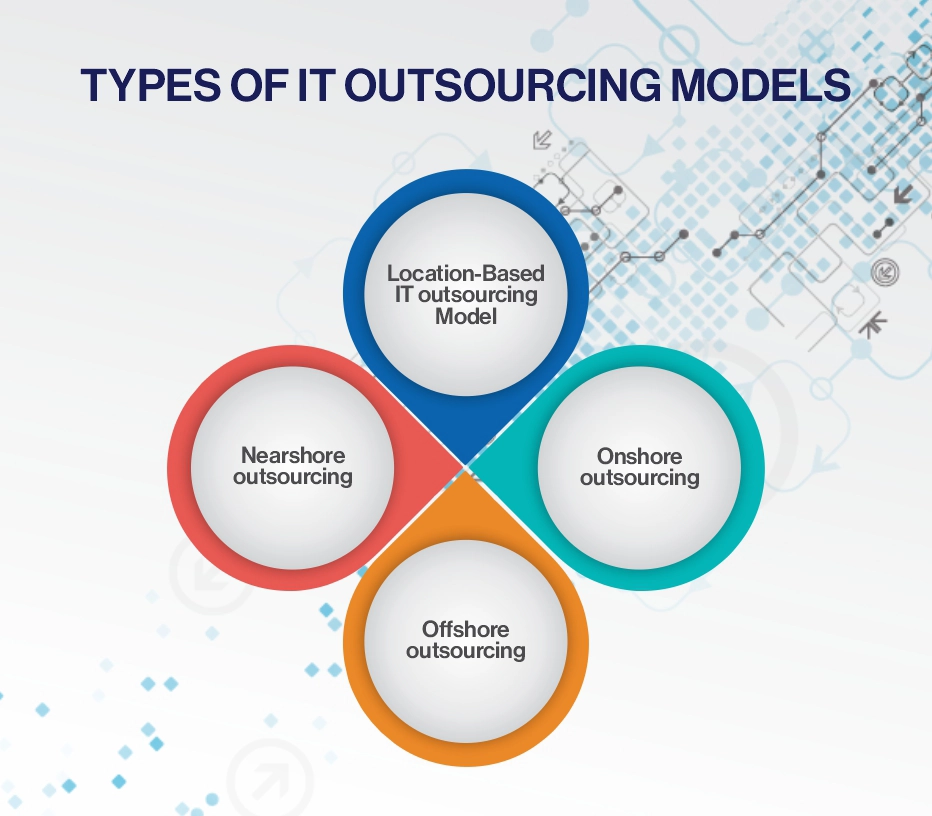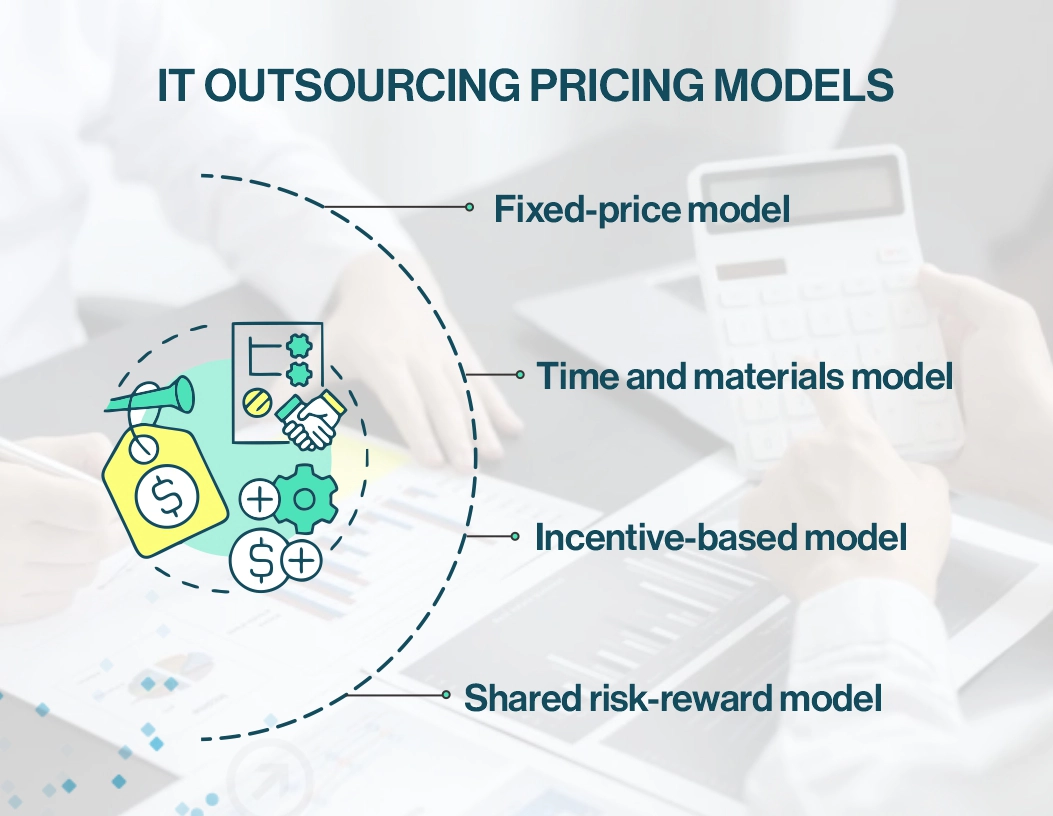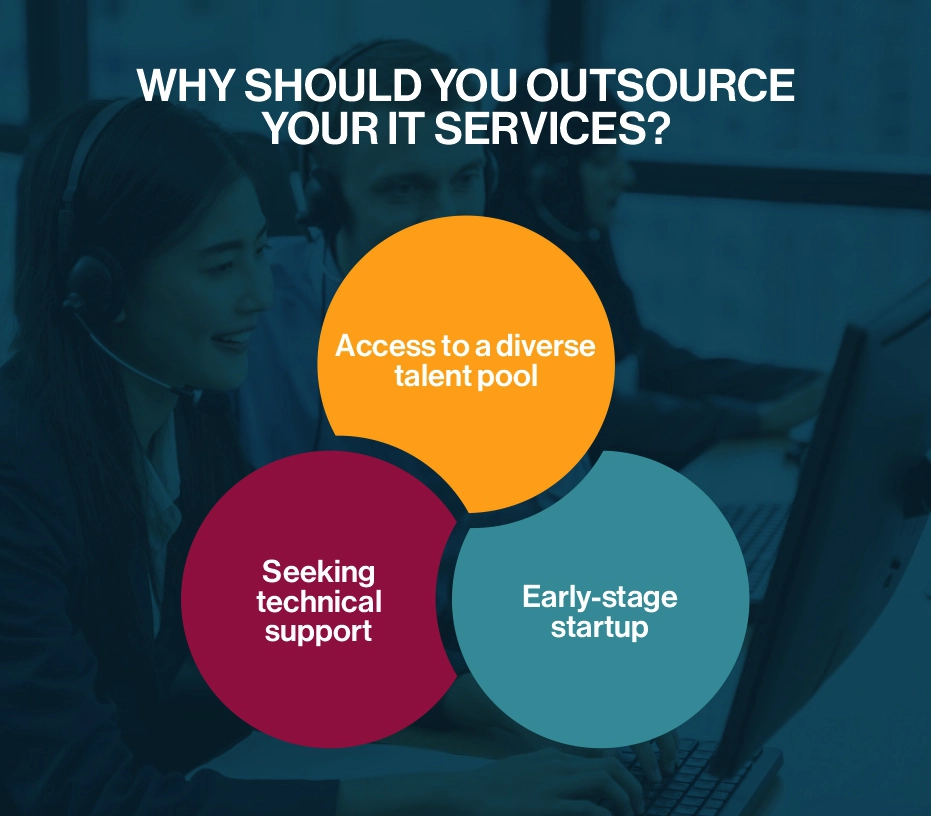Building an in-house development team is great if you’ve got the budget or can find top talent. But for most other scenarios, outsourcing does the job splendidly. According to Statista, in 2023, reports indicated that the global IT outsourcing market soared to an estimated $430.53 billion and marked unprecedented growth.
The variety of IT outsourcing models available today can be overwhelming. The choices are vast, from turn-key solutions to augmenting your team with their experts, from offering project management to solely providing technical talent. Businesses have achieved remarkable savings by unburdening themselves from costly assets and experiencing growth far beyond what they could achieve with in-house resources.
Outsourcing lets companies focus on what they do best, while skilled offshore teams handle development tasks. This collaboration between companies, even from different backgrounds, has grown significantly, cutting costs and saving time. Smaller businesses extend their teams with IT outsourcing service companies, while larger corporations establish global offices to access diverse talent.
What are IT outsourcing services?
IT outsourcing serves as a way for companies to access IT assistance and skills without managing them internally. For example, a new business might opt to contract out its entire IT department or just specific duties like web hosting or email support.
Outsourcing is advantageous for startups due to their limited resources and initial lack of need for extensive IT services. As your company establishes its operations and starts generating income, it becomes worthwhile to reassess your existing collaboration with the IT provider. Before deciding whether to do certain tasks in-house or continue to outsource them, it’s important to reassess the situation. This will help you determine if expanding your current outsourced relationships for a more inclusive arrangement is necessary.
In-House vs. Outsourced Software Development
When weighing in-house vs. outsourcing software development teams, opting for outsourcing is a great move. The appeal of this option is being able to tap into a skilled group of professionals while keeping costs low. Outsourcing ensures quality standards and timely delivery while allowing business owners to concentrate on core organizational values as the external team manages operations.
Yet, the choice between in-house and software project outsourcing teams depends on the project’s functional and non-functional needs and resource requirements. What works for one project or company might not work for another. Sometimes, a hybrid approach combining both strategies yields the best results. In the end, the right decision is the one that best aligns with the needs of your project and company.
Types of IT Outsourcing Models
As businesses vary in their project development needs, there isn’t a universal hiring model suitable for all. Considering factors like your location, budget, and project specifications, we’ve classified these into three IT outsourcing models. Now, let’s have a look at what are the different types of IT outsourcing.
Location-Based IT Outsourcing Model
When deciding on an outsourcing plan, where your team is located matters. It can impact how well you work together. The main things to consider are their proximity, time zone differences, and whether your cultures match. Let’s explore the main IT outsourcing types:
Onshore Outsourcing
Onshoring is when you give IT tasks to a vendor in your own country. Since both the client and vendor are in the same country, it’s also known as homeshoring. Choosing onshore outsourcing lets you tap into local talent without growing your in-house team and dealing with extra costs. It’s flexible, helping fill skill gaps as needed without long-term commitments. Onshore teams being nearby means easy face-to-face meetings and better project collaboration.
The geographical proximity of onshore companies and personnel means they’re in the same time zone, facilitating face-to-face meetings, presentations, and regular reports. Clients benefit from the convenience of in-person visits, fostering efficient project management and relationship-building through outsourcing.
Nearshore Outsourcing
Nearshore outsourcing is when you give your IT work to a vendor in a nearby country. They’re usually in a time zone like yours, only a few hours apart. Businesses often pick nearshore outsourcing for cost savings, especially in regions with high labor costs. Nearshoring offers even more benefits. By reaching out to nearby countries, you get access to more service providers and skilled developers at mid-range prices. It’s a win-win: you save money while getting quality work.
Being close by means easier communication, faster reactions, and fewer travel issues. Also, cultural similarities and shared languages minimize conflicts. If there are any disagreements, you can sort them out in person with minimal hassle.
Offshore Outsourcing
Offshore outsourcing is when a company hires an external provider from another country to handle its IT tasks. Offshore outsourcing saves money by hiring teams in other countries with lower wages, like paying $15–25 per hour instead of $200 per hour in the U.S. This helps startups with limited budgets.
It’s great for getting skilled workers from different places, but it can be tough to communicate due to distance and time zones. It works best for tasks that can be done remotely, but language and cultural differences might cause some challenges in communication.
Relationship-Based IT Outsourcing Models
There are different types of outsourcing models beyond those based on location. Relationship-based models fall into three categories, depending on how you interact with the outsourced team:
Staff Augmentation
Staff augmentation, or workforce augmentation, is an IT outsourcing approach that fills skill gaps within your existing teams. It’s a solution for non-IT companies that occasionally have IT projects without wanting to hire permanent staff. This model eliminates the need to hire full-time employees when you only require on-demand specialists for specific projects.
In this setup, the workers supplied to you are on the vendor’s payroll. You pay solely for the service, and the augmented staff work full-time for you until the contract ends. All expenses related to compensation and benefits are managed by the staff augmentation vendors.
Dedicated Team Model
The managed or dedicated team approach involves hiring a separate development team to handle certain parts of your project. This team operates independently, often with its own project manager. Communication typically goes through the dedicated team’s manager or the client’s project manager or CTO.
Choosing a dedicated team is helpful when you require specialized expertise focused solely on your project. It works well when your main team is occupied with your core product, and you need support for a side project.
Project-Based Model
The project-based model means handing over the entire software development process to an outsourcing company. They handle everything from planning to the final release. Both the customer and the outsourcing provider agree on project details, timelines, and what needs to be delivered. Vendor project managers oversee the development, with the customer having minimal involvement in daily operations.
This approach suits small companies, startups, and projects where the client has a clear idea of the product they want to create.
IT Outsourcing Pricing Models
Choosing the right pricing model for your IT outsourcing agreement is a key decision impacting your budget and project flexibility. There are four main rates to consider:
Fixed-Price Model
The fixed price (FP) model is a traditional outsourcing pricing method where the service provider charges a set rate agreed upon with the client. Payment is made in full once the project is finished.
This model carries a higher risk, so service providers often request some payment flexibility to manage uncertainties.
Time and Materials Model
Time and materials (T&M) contracts are popular in IT projects and outsourcing. In this model, service providers bid based on client needs and provide a proposal.
With this model, the vendor team handles operations either in-house or under the client’s direct supervision.
Incentive-Based Model
This model rewards the development team with extra pay if they do better than what was originally agreed upon. It’s a way to motivate the team and make everyone feel good about their work.
Shared Risk-Reward Model
This model is a bit like an incentive plan, but it goes beyond just sharing successes. The shared risk-reward model aims to improve projects by splitting financial risks between the vendor and the client. It’s especially helpful for trying out new processes, models, or technologies while reducing overall risks.
Why Should You Outsource Your IT Services?
After understanding what IT outsourcing entails, including information technology outsourcing services, let’s explore why it’s beneficial and when it might be the right choice for you.
Access to a Diverse Talent Pool
An IT outsourcing service can be your best bet because they have a diverse talent pool that you can utilize. Your primary aim here is to enter the market and test your solution swiftly. Outsourcing teams can assist in validating your idea, creating an MVP to test your hypothesis, and adapting your product to meet market demands. This approach saves both time and money while enabling you to achieve your goals.
Early-Stage Startup
Many startups face financial strain before establishing a solid team and a market-ready product. Financial issues rank as the third reason for startup failures. To conserve funds, consider hiring the best software outsourcing companies while your business operates on investor funds. Engaging a full-cycle product development company can address a lot of concerns and breathe life into your product.
Seeking Technical Support
If your existing solution requires technical enhancements like backend frameworks, language updates, enterprise app integrations, or UX/UI design, looking for experienced tech outsourcing companies is beneficial. IT outsourcing can handle various functions, saving you time searching for qualified staff.
How to Choose the Right IT Outsourcing Models?
While there’s no one-size-fits-all answer, we’re here to steer you in the right direction. Here’s what to choose best from IT service outsourcing models:
- Clearly define the work scope
- Prioritize expertise and experience
- Evaluate market reputation
- Set clear budget parameters
- Ensure data and IP security
- Choose a flexible partner
If you can answer these questions, you’ll decide on the perfect IT outsourcing model.
Moreover, if you want to know whether an in-house team is better or an outsourced team, you can read our in-depth guide:
In-House Vs Outsourcing Software Development
Understanding Your Project Needs Before Outsourcing
Before exploring outsourcing, having a clear grasp of your project requirements is key to avoiding pitfalls. Consider these essential questions:
- What’s the scope of your project?
- What core functionalities do you need in the final product?
- Have you established project milestones?
- What are the agreed-upon timelines?
Defining Your Engagement Style
What level of engagement do you prefer with your IT outsourcing service company? Would you rather delegate the project and await its completion before engaging, or do you prefer involvement throughout the development process? Moreover, also ensure criteria for quality assurance and quality control with your outsourcing partner.
Your chosen relationship style with your IT outsourcing partner is crucial in determining the most suitable outsourcing model for effective project management.
Choosing Your Pricing Model
Establishing a fixed IT outsourcing cost and exploring diverse pricing models are crucial for outsourcing your project’s services.
Based on required services and resource expertise, options like fixed price, value-based, or competitive pricing models can be considered. Once your budget is set, you can focus your search on a reputable outsourcing company that aligns with your project’s distinct needs within your budget constraints.
Grow Your Business with FiveRivers Technologies’ IT Excellence
FiveRivers Technologies stands as a prominent IT outsourcing company. Renowned for technological expertise, we deliver high-caliber IT solutions by leveraging cutting-edge technologies like artificial intelligence and machine learning to drive business growth. Our services include software quality assurance, development, data science and AI, DevOps, UI/UX design, and more.
With specialized teams dedicated to software development, SaaS product development, and following the waterfall model for software engineering, FiveRivers Technologies helps businesses develop top-tier software aligned with market trends and customer expectations. Its streamlined software delivery process has garnered many global clients. Outsource your IT project to us at an affordable IT outsourcing cost!
FAQs
What is Outsourcing in Information Technology?
IT outsourcing refers to leveraging external service providers to efficiently deliver IT-driven business processes, application services, and infrastructure solutions to achieve desired business outcomes.
What is The Most Commonly Outsourced IT Service?
Outsourcing the management of IT software is common due to its time-consuming nature. This approach enables companies to hire more effectively, adapt to evolving project requirements, and consistently uphold budgetary constraints.
When Should You Outsource IT Services?
Outsourcing might be the ideal choice if cost reduction or offloading IT responsibilities are your goals. However, if retaining complete control over your technology infrastructure is a priority, hiring an in-house team is likely a better fit.











